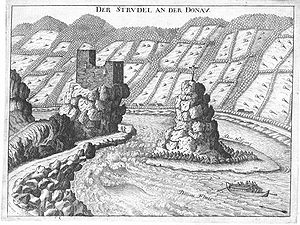Werfenstein Castle
| Werfenstein Castle | ||
|---|---|---|
|
Werfenstein ruins and Wörth island around 1674, engraving by GMVischer |
||
| Creation time : | 1242 | |
| Castle type : | Niederungsburg, locality | |
| Conservation status: | ruin | |
| Construction: | Quarry stone masonry | |
| Place: | Struden, parish of St. Nikola an der Donau | |
| Geographical location | 48 ° 13 '47.4 " N , 14 ° 53' 32.2" E | |
|
|
||
Werfenstein is the ruin of a Niederungsburg in Upper Austria's Mühlviertel . It stands on the Danube in the village of Struden in the municipality of St. Nikola an der Donau . When the castle was besieged, the besieged are said to have defended themselves by throwing stones and that's how they gave the castle its name.
Location and buildings
- Werfenstein Castle
Epitaph at the staircase
The castle was built on a strategically important point. It also included fortifications on the opposite island of Wörth . If necessary, the Danube could be closed to shipping by stretching chains between the two systems. Downstream there were other similar systems.
The former outer bailey was demolished at the beginning of the 20th century when the Donauuferbahn was built . Parts of the curtain wall and the tower have been preserved. The tower-like corner of the main castle consists of layered masonry , the others of quarry stone masonry . The west and south sides were probably added in the late Gothic period . The keep was restored in 1907. The old front door is seven meters above the courtyard. There was once a larger extension in front of today's entrance. The current area of the castle is 716 m².
history
The castle was first mentioned in a document in 1234. The name goes to ahd . hwërbo (vortex, vortex) back. Werfenstein means something like rock on the Danube strudel. From 1272 to 1293 a Herwicus von Werfenstein is mentioned here as a supporter of the Teutonic Knight Order . In 1294 Duke Albrecht II besieged the castle. Werfenstein and the castles Freyenstein and Pain were besieged for three weeks . They had the castle administered by burgraves . King Rudolf left Werfenstein to Konrad von Summerau . In 1314 Duke Friedrich pledged the castles Werfenstein, Hausstein and Pain to Albert von Volkenstorf . Heinrich Payr was burgrave between 1319 and 1320. The lordship was returned in 1334. In 1416, Duke Albrecht followed as the owner, who was replaced in 1422 by Erhard Volkra. In 1461 Werfenstein fell to Duke Siegmund of Tyrol . Under Emperor Friedrich III. Werfenstein was sold in 1488 to the brothers Sigmund and Heinrich Prueschenk (the later Counts of Hardegg ).
The castle was abandoned at the end of the 15th century after the Prueschenks had moved to the newly built Greinburg . Werfenstein was already without a roof in 1531. In 1645 the already dilapidated castle burned down. 1780 was Palas demolished a nearby street because of the danger of collapse and the threat. Until the end of the 19th century, Werfenstein belonged to the Grein rule and was owned by the dukes of Saxe-Coburg and Gotha . When Queen Victoria of England was the owner of the Greinburg estate, the English court courier Julius Joseph Kanné resided in Werfenstein. So Werfenstein was not a complete ruin, but was repeatedly used for residential purposes.
In 1907 Jörg Lanz von Liebenfels acquired the ruins from Kanné's successors and expanded it into the “Ordensburg” of his folk-esoteric New Templar order . In 1963 the castle was sold again and turned into a private retirement home by the Linz doctor. After his death in the mid-1990s, the property changed hands again.
tourism
The castle is from the Danube and the Danube Bike Path visible, since 2010 leading Donausteig the Danube round castle Werfenstein past it.
See also
literature
- Norbert Grabherr : Castles and palaces in Upper Austria. A guide for castle hikers and friends of home . 3. Edition. Oberösterreichischer Landesverlag, Linz 1976, ISBN 3-85214-157-5 .
- Oskar Hille: Castles and palaces in Upper Austria then and now . Verlag Ferdinand Berger & Sons, Horn 1975, ISBN 3-85028-023-3 .
- Walther Paape: That's why we founded a temple house. The New Templar Order (Ordo Novi Templi, ONT) of Lanz von Liebenfels and his Archpriorate Staufen in Dietfurt near Sigmaringen. Gmeiner-Verlag, Meßkirch, 1st edition, November 2007, ISBN 3-89977-205-9 .
Web links
- Entry on Werfenstein in the scientific database " EBIDAT " of the European Castle Institute
- Entry via Werfenstein to Burgen-Austria
- Entry on Werfenstein Castle in the Austria Forum
- Say: The black monk on Werfenstein
- Sage: From the cross on the island of Wörth (below)
- Say: The Schusterstein near Grein






